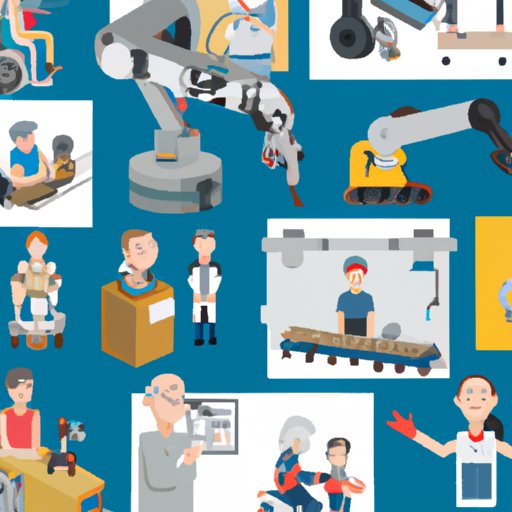Introduction
Robotics is a rapidly advancing field that has made tremendous progress over the past few decades. It involves the use of machines to perform automated tasks, such as manufacturing products and providing medical care. The potential benefits of robotics are vast and could have immense implications for our society. In this article, we will explore some of the ways in which robots can benefit society.
Definition of Robotics
Robotics is the science of designing, constructing, and operating robots. A robot is a machine that can be programmed to perform certain tasks autonomously or with minimal human intervention. Robots are used in a variety of industries, from manufacturing to healthcare to transportation. They are also used in personal applications, such as domestic cleaning and security.

Overview of the Benefits of Robotics
Robots can provide a number of benefits to society, including automation of dangerous tasks, improved quality and efficiency in manufacturing, enhanced accessibility to healthcare, increased productivity for businesses, and improved quality of life for elderly and disabled individuals.
Automation of Dangerous Tasks
Robots can be used to automate dangerous tasks that would otherwise be too risky for humans to perform. This includes tasks such as welding, demolition, and hazardous material handling. Automating these tasks can reduce the likelihood of injury or death, as well as increase efficiency and accuracy.
Description of Types of Tasks
Robots can be used to automate a variety of dangerous tasks, such as welding, demolition, hazardous material handling, and mining. These types of tasks are often too risky for humans to perform due to the potential for injury or even death. By automating these tasks, robots can help reduce the risk of injury or death by eliminating the need for human intervention.
Advantages of Automated Tasks
Automating dangerous tasks can provide a number of advantages, including increased safety, improved accuracy, and increased efficiency. According to a study published in the International Journal of Advanced Robotic Systems, “Robots can work faster than people, with greater precision and accuracy, and with less risk of injury.” Additionally, robots can be programmed to operate in hazardous environments that would otherwise be too dangerous for humans to enter.
Improved Quality and Efficiency in Manufacturing
Robots can be used to automate various manufacturing processes, such as assembly, welding, and painting. Automating these processes can result in improved quality and efficiency in manufacturing, as robots can work faster and more accurately than humans.
Examples of Automated Manufacturing Processes
Robots can be used to automate a variety of manufacturing processes, such as assembly, welding, painting, and packaging. For example, robots can be used to assemble components, weld parts together, paint surfaces, and package finished products. Automating these processes can result in improved quality and efficiency in manufacturing.
Benefits of Automation in Manufacturing
Automating manufacturing processes can provide a number of benefits, including increased speed and accuracy, improved product quality, and reduced costs. According to a study published in the International Journal of Advanced Robotic Systems, “Robots can work faster than people, with greater precision and accuracy, and with less risk of injury.” Additionally, automating manufacturing processes can reduce labor costs, as robots do not require wages or benefits.
Enhanced Accessibility to Healthcare
Robots can be used to enhance accessibility to healthcare, as they can be used to perform a variety of medical procedures, such as surgery, diagnosis, and rehabilitation. Automating these procedures can result in improved patient outcomes and increased efficiency.
Examples of Robotic Medical Applications
Robots can be used to perform a variety of medical procedures, such as surgery, diagnosis, and rehabilitation. For example, robots can be used to perform minimally invasive surgeries, diagnose illnesses, and assist with physical therapy. Additionally, robots can be used to deliver medications and other treatments to patients.
Benefits of Robotic Medical Applications
Robotic medical applications can provide a number of benefits, including improved patient outcomes and increased efficiency. According to a study published in the International Journal of Advanced Robotic Systems, “Robots can perform complex tasks more accurately and efficiently than humans, resulting in better patient outcomes.” Additionally, robots can reduce the amount of time required to perform medical procedures, as they can work faster than humans.
Increased Productivity for Businesses
Robots can be used to increase productivity for businesses, as they can be used to automate a variety of tasks, such as data entry, customer service, and inventory management. Automating these tasks can result in increased efficiency and cost savings.
Examples of Business Applications
Robots can be used to automate a variety of business tasks, such as data entry, customer service, and inventory management. For example, robots can be used to process orders, answer customer inquiries, and track inventory levels. Automating these tasks can result in increased efficiency and cost savings.
Benefits of Robotic Business Applications
Robotic business applications can provide a number of benefits, including increased efficiency and cost savings. According to a study published in the International Journal of Advanced Robotic Systems, “Robots can perform complex tasks more quickly and accurately than humans, resulting in increased efficiency and cost savings.” Additionally, robots can reduce the amount of time required to complete tasks, as they can work faster than humans.

Improved Quality of Life for Elderly and Disabled Individuals
Robots can be used to improve the quality of life for elderly and disabled individuals, as they can be used to assist with daily activities, such as cooking, cleaning, and mobility. Automating these tasks can reduce the burden on caregivers and increase independence for those with disabilities.
Examples of Assistive Technology
Robots can be used to assist elderly and disabled individuals with a variety of daily tasks, such as cooking, cleaning, and mobility. For example, robots can be used to prepare meals, clean the house, and assist with mobility devices. Additionally, robots can be used to monitor vitals, remind individuals to take their medication, and provide companionship.
Benefits of Assistive Technologies
Assistive technologies can provide a number of benefits, including increased independence and improved quality of life. According to a study published in the International Journal of Advanced Robotic Systems, “Robots can help elderly and disabled individuals remain independent by assisting with daily activities.” Additionally, robots can reduce the burden on caregivers, as they can take over tedious or difficult tasks.
Conclusion
Robotics can provide a number of benefits to society, including automation of dangerous tasks, improved quality and efficiency in manufacturing, enhanced accessibility to healthcare, increased productivity for businesses, and improved quality of life for elderly and disabled individuals. As robotics technology continues to advance, the potential benefits are sure to expand, making robots an increasingly valuable tool for improving society.
Summary of Benefits
In summary, robotics can provide a number of benefits to society, including automation of dangerous tasks, improved quality and efficiency in manufacturing, enhanced accessibility to healthcare, increased productivity for businesses, and improved quality of life for elderly and disabled individuals.
Final Thoughts on the Impact of Robotics on Society
Robotics has the potential to revolutionize the way we live and work. As the technology continues to advance, the benefits of robotics are sure to expand, making robots an increasingly valuable tool for improving society. From manufacturing to healthcare to everyday tasks, robotics can make our lives easier, safer, and more efficient.
(Note: Is this article not meeting your expectations? Do you have knowledge or insights to share? Unlock new opportunities and expand your reach by joining our authors team. Click Registration to join us and share your expertise with our readers.)
